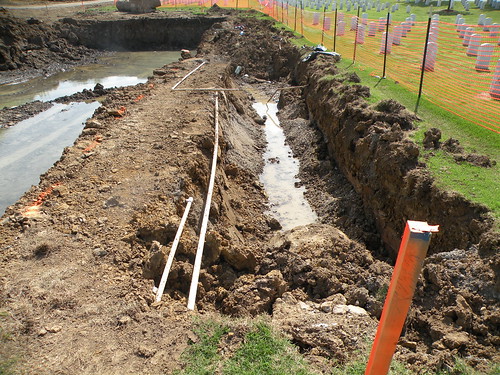This
Earth Day we need more than a celebration. We need a
clean energy revolution that creates 2 million jobs, cuts 2 billion tons, and saves 2 trillion dollars.
On the 40th anniversary of the first Earth Day there is
much to celebrate: Our air is cleaner and our rivers no longer catch on fire. But we can't rest on our laurels when millions of Americans still breathe unhealthy air and the concentration of heat-trapping carbon dioxide in Earth's atmosphere continues to rise. The next step for
our environment,
our economy, and
our security is a comprehensive clean energy and climate bill that adds 2 million clean energy jobs, cuts pollution by 2 billion tons, and saves 2 trillion dollars worth of oil imports. That may sound like a tall order, but those benefits are within reach if Americans join together to demand action as they did on the first Earth Day.
Senators John Kerry (D-Mass.), Lindsey Graham (R-S.C.), and Joe Lieberman(I-Conn.) (KGL) have been working on a bipartisan proposal for months. They are now expected to
unveil it on April 26.
Here is what this legislation could do for our country:
Add 2 million jobs. Comprehensive clean energy and climate legislation will create jobs for three reasons. First, enacting legislation will end more than a decade of uncertainty about the direction of U.S. policy, allowing both big energy companies and entrepreneurial start-ups to
invest with confidence that the recent growth in the clean energy market will only accelerate. Second, clean energy sources generate over three times as many jobs per dollar spent than traditional fossil energy supplies. Third, building a robust domestic clean energy market will position U.S. firms to compete effectively in the rapidly expanding global clean tech arena. A
University of California study found that the energy and climate bill which passed the House in June could create as many as 1.9 million jobs by 2020. The Senate only needs to do slightly better to hit the 2 million job target.
Cut 2 billion tons. That's the scale of global warming pollution reductions we need by 2020 to get on track to avoid the worst dangers from global warming. The only way to achieve this target is to set effective limits on carbon pollution from all major sources and tighten those limits each year. Strong complementary policies are also needed to accelerate energy efficiency improvements and ease the transition to a renewable energy economy. And supplemental policies are needed to reduce emissions from deforestation and forest degradation. Both the House bill and the climate bill reported by the Senate Environment Committee last fall
meet this two billion ton test. How will KGL match up?
Save 2 trillion dollars. That's the reduction in the amount of money we would send overseas to import oil over the next forty years if we enact an effective clean energy/climate bill according to
NRDC's analysis. A comprehensive bill would achieve this in three ways. First, setting an overall limit on oil pollution and requiring oil companies to obtain emission permits to cover the carbon content of their products would create an incentive to shift to cleaner fuels and more efficient ways to get around that gets stronger every year. Second, setting stronger standards to reduce vehicle tailpipe emissions would continue the historic progress codified in the clean car rules that were finalized on April 1. Third, carbon dioxide captured from power plants and industrial facilities due to the pollution limits placed on those sources would be available to enhance oil production from aging oil fields in the United States without drilling in pristine areas. The Senate appears to be even more focused on increasing our energy security than the House, so there is reason for optimism on this score.
How will we know if the KGL proposal stacks up against these benchmarks? Detailed model runs will take some time, but there are four key aspects of the legislation to focus on to make a preliminary assessment.
Are the emission limits effective and free of loopholes? KGL have indicated that their goal is to reduce emissions 17 percent by 2020 and 80 percent by 2050, consistent with the commitments President Obama made in
Copenhagen. The keys to actually achieving these targets are emission limits that comprehensively cover all major sources, strong quality controls for any offsets, and cost containment measures that maintain the effectiveness of the emission limits.
Does the new national emission reduction program build on existing state and federal efforts? During the eight long years of Bush administration inaction the States stepped into the void and have already begun implementing emission reduction programs. They also sued EPA, leading to the Supreme Court decisions declaring that the agency does indeed have authority to regulate greenhouse gases under the Clean Air Act in its current form. EPA has issued vehicles standards and is steadily moving to exercise its authority to regulate stationary sources. While an effective new national program would become the primary driver of emission reductions it would be a mistake to eliminate the authority states and EPA currently have. As NRDC President Frances Beinecke asks in
her recent post, would you fly in a plane that had no backup systems?
Does the bill include smart clean energy policies that will create jobs quickly and accelerate the transition to an efficient renewable energy economy? Energy efficiency is the fastest and cheapest way to reduce carbon pollution. And it creates jobs for Americans all across the country that can't be outsourced. After all, a call center in India can't put insulation in your attic, and it's cheaper and faster to remanufacture old inefficient windows into superefficient ones on site (as Serious Materials is doing at the
Empire State Building) than it is to import windows from China. Emission limits by themselves are not sufficient to overcome the barriers to energy efficiency and ensure a steadily expanding homegrown renewable energy market. The key here is complementary standards and incentives that help individuals and companies seize the wide array of available opportunities.
Would the bill create a foundation for an effective international agreement by demonstrating U.S. leadership, funding efforts to reduce emissions from deforestation, and helping the poorest countries adapt to impacts of global warming that can no longer be avoided? Efforts to forge an international agreement capable of preventing dangerous global warming are doomed without strong U.S. leadership, including a domestic law that reassures our partners that the president can deliver on his commitments and that the next administration can't easily renege on them. Serious domestic emission reductions are critical, but
adequate funding for international programs to curb deforestation and help poor countries deal with the consequences of global warming are also essential to seal the deal.
Can the Senate pass a bill that delivers 2 million jobs, 2 billion tons and $2 trillion? It won't be pretty and it won't be perfect, but if the public demands action there are good reasons for optimism. Now that the arduous battle for healthcare reform is over, President Obama is
turning his attention to comprehensive energy reform. With his leadership, combined with the bipartisan efforts of Kerry, Graham, and Lieberman and the commitment of Senate Majority Leader Harry Reid, a clean energy revolution is within grasp.
Join me for a live event with Lisa Jackson, Andy Revkin and others, April 20 at 7 p.m. Eastern to discuss what's next for climate policy. For details and to submit a question, go to PlanetForward.org. Watch a live stream of the panel and conversation, join the chat and submit questions for the panel.  NEW ORLEANS - A Coast Guard MH-65C dolphin rescue helicopter and crew document the fire aboard the mobile offshore drilling unit Deepwater Horizon, while searching for survivors April 21, 2010. Multiple Coast Guard helicopters, planes and cutters responded to rescue the Deepwater Horizons 126 person crew. U.S. Coast Guard photo by Petty Officer 2nd Class Scott Lloyd.Rescuers have found the 11 people who went missing shortly after the oil drilling rig they were aboardexploded and caught fire in the Gulf of Mexico late Tuesday, according to Plaquemines Parish President Billy Nungesser.
NEW ORLEANS - A Coast Guard MH-65C dolphin rescue helicopter and crew document the fire aboard the mobile offshore drilling unit Deepwater Horizon, while searching for survivors April 21, 2010. Multiple Coast Guard helicopters, planes and cutters responded to rescue the Deepwater Horizons 126 person crew. U.S. Coast Guard photo by Petty Officer 2nd Class Scott Lloyd.Rescuers have found the 11 people who went missing shortly after the oil drilling rig they were aboardexploded and caught fire in the Gulf of Mexico late Tuesday, according to Plaquemines Parish President Billy Nungesser.

 Bronze iris
Bronze iris







































